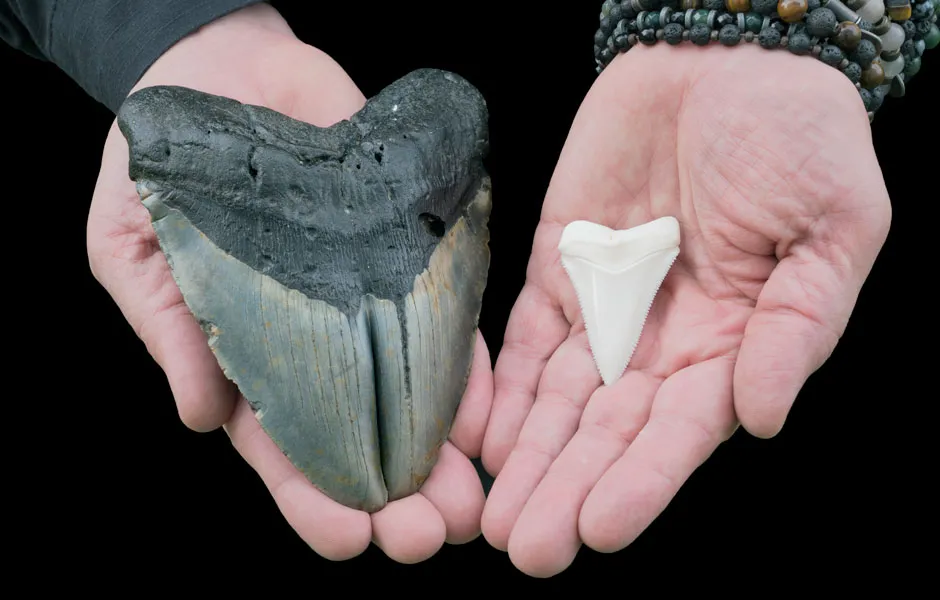Scared by Jaws? Then best hope you don’t run into a megalodon shark, an animal that makes any great white look like an absolute great big wuss.
That’s because not only are they the largest sharks to have ever lived, but also one of the most dominant creatures to roam the oceans, their predator patterns shaping entire marine ecosystems.
However, bar finding yourself in a rickety speedboat with Jason Statham, it’s unlikely you’ll ever cross paths with one. The apex predator is now extinct, its remarkable size only revealed to humans through tooth fossils.
Yet while long gone, the megalodon has left a lasting impact on our imaginations. And, judging from the facts below, deservedly so.
What size was a megalodon shark?
Big. Seriously big. The megalodon shark was roughly 16 metres in length – longer than your normal bus, and three times the length of the average great white shark. Scientists also estimate that their fins were the length of an average adult human.
Due to the lack of fossil evidence, we can’t be sure of their exact build. However, using mathematical methods and comparisons with living relatives of the megalodon, scientists have provided some estimates.
For instance, the University of Bristol and Swansea University have calculated a megalodon is likely to have had a head around 4.65 metres long, a dorsal fin approximately 1.62 metres tall and a tail around 3.85 metres high.
Research has also suggested that megalodons were a massive two metres in length at birth.
How big were megalodon teeth?
As ‘megalodon’ actually means ‘giant tooth’ in ancient Greek, there’s no surprise the sharks wielded gigantic gnashers.
Each shark had 276 teeth, each measuring up to 18cm long. Unlike other parts of the megalodon skeleton, which was made from cartilage, each tooth was formed by hard dentin (like human teeth).

From fossils, we can gather a megalodon’s jaw would span around 3 by 3.5 metres wide. That’s big enough to fit at least two fully-grown Vin Diesels in at once.
Megalodons would lose a complete set of teeth between every one and two weeks. This means they would produce up to 40,000 teeth during their lifetime, explaining why these fossils are so common.
How hard could a megalodon bite?
It is estimated that megalodons could exert a force of up to 182,200 newtons, giving them the hardest bite of any ever creature known on Earth.
In comparison, the Tyrannosaurus rex could bite with a force of 60,000 newtons, while the Nile alligator (who has the strongest bite of any living animal on Earth today) can manage 22,000 newtons.
When did the megalodon go extinct?
Becoming extinct just 3.6 million years ago, megalodon fossils date up to 20 million years in the past (from the Early Miocene and Pliocene periods). This means they died out before the earliest Homo sapiens species emerged, roughly 2.5 million years ago.
The reason behind the megalodon’s extinction isn’t yet clear, although some have theorised the sharks were killed off by a period of global cooling. However, other studies have suggested that the megalodon died out due to a lack of suitable prey, alongside the appearance of predators like the great white shark, who also depleted the megalodon’s food source.
Read more about sharks
- Megalodon shark was an absolute unit, scientists confirm
- What is a goblin shark?
- The world’s biggest fish are female
Was the megalodon shark a dinosaur?
Although megalodons existed many millions of years in the past, they can’t truly be considered dinosaurs, who died out around 66 million years ago. This means the two never coexisted.
Were the megalodons cannibals?
Funny you should ask: research has suggested that megalodon sharks ate their siblings in the womb. According to a study by palaeobiologists at Chicago’s DePaul University, it’s likely that embryonic megatooth sharks fed on unhatched eggs in their mother’s womb.
Present-day lamniform sharks also engage in this pre-birth cannibalism, known as oophagy, to ensure they exit the womb at a size big enough to compete with other predators.